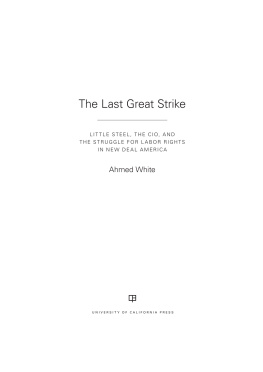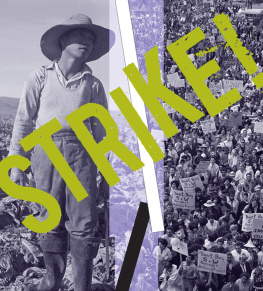ACKNOWLEDGMENTS
I was first enthralled by the story of Little Steel and the CIO seven years ago, while researching other episodes of labor conflict in the New Deal era. Soon convinced that the strike had not received nearly the attention from researchers that it deserved, I set out to write this book. As I suppose is often the case with first-time authors of books like this one, my enthusiasm for the project may have led me to underestimate the challenges that lay ahead. But I was also fortunate, for a number of people and institutions helped me along. It is my pleasure to acknowledge their support in bringing this story to print.
I must stress at the outset how grateful I am to my editor at the University of California Press, Neils Hooper, and his assistant, Bradley Depew, for their faith in this project and their labors in helping to produce a publishable work. I am equally indebted to Kate Hoffman and Julie Van Pelt for their help in editing the manuscript for publication and to the reviewers of this book, most of them still anonymous, who found merit in the manuscript and provided me with useful recommendations and advice. And I am beholden to Cecelia Cancellero for the excellent work she did in preparing the manuscript for review and shepherding it through the process.
Quite a few librarians and archivists aided me in negotiating archival sources and putting together the research on which this book is based. This book would have been impossible without Penn State Universitys Historical Collections and Labor Archives, an outstanding institution that houses the records of the United Steelworkers of America and its predecessor, the Steel Workers Organizing Committee. My efforts there benefited tremendously from the generosity and expertise of librarians James Quigel Jr. and Barry Kernfeld. Equally important were the collections of government, union, and company records at the Ohio Historical Society, in Columbus, and the Youngstown Historical Center of Industry and Labor. There, too, the librarians and archivists were models of professionalism and patience. I am compelled to give special thanks to Martha Bishop at the Youngstown Historical Center, who very generously accommodated my frenzied schedule at the expense of her own time and convenience. I was similarly favored at the Western Reserve Historical Society in Cleveland, where I was granted access to the records of the Republic Steel Corporation, and at the Chicago Historical Society, home to significant regional union records and important documents pertaining to the strikes deadliest incident. And I received vital, last-minute assistance from the staff of the American Catholic History Research Center and University Archives at Catholic University in Washington, DC.
A number of friends and colleagues, including Emily Calhoun, Kenneth Casebeer, David Hill, Alan Hyde, James Pope, and Pierre Schlag, generously read the entire manuscript and provided me with valuable commentary and constructive criticisms. Ellen Dannin closely and critically reviewed an early introductory section of the manuscript, and Michael Goldfield listened patiently and responded incisively to my descriptions of the project. Jane Thompson, librarian at the University of Colorado School of Law, and her assistant, Matt Zafiratos, gave me crucial research support, especially with respect to securing obscure secondary sources. Nefertari Kirkman-Bey, Marissa McGarrah, Liana Orshan, Hunter Swain, and Tarn Udall, all former students of mine, provided valuable research assistance. Along with my faculty assistants, Nicole Drane and Charlie Bowers, whose unfailingly courteous efforts advanced many aspects of this project, Tarn also exceeded all reasonable expectations in working to secure copyright permissions for the images that illustrate the book.
I wrote this book entirely during my service on the faculty of the University of Colorado School of Law, where, I am happy to say, I found the standard resources more than adequate to cover the costs of research and travel, as well as my own upkeep. Among other advantages, this privileged circumstance spared me the troubleand, dare I say, contradictionof seeking financial assistance from corporate entities, or from the foundations, fellowships, and prizes they fund, in order to write this book about class struggle and the dangers of corporate power. For this, I am most grateful to the students and the people of the state of Colorado.
I presented aspects of the research that comprises this book on several occasions over the years. The strike was the topic of the 2009 Austin Scott Lecture at my own institution, as well as of presentations at Loyola Law School, Los Angeles, the Boyd School of Law at the University of NevadaLas Vegas, the 2010 How Class Works Conference at SUNYStony Brook, the 2012 ClassCrits Conference at the University of WisconsinMadison, and the 2013 Cleveland Laborfest and Forum. At each of these gatherings, I received a host of helpful suggestions, criticisms, and encouragements from scholars, community activists, and, perhaps most notably, former steel workers and their children.
I am bound to give special thanks to other friends, including the late Don Wright. A veteran of more recent struggles in steel and a thoroughly remarkable individual, Don shared stories of that period in his life during a holiday party in Aurora, Colorado, on a frigid night in 2008, which did much to motivate me to write about Little Steel. Unfortunately, Don never realized this. I also owe a debt of gratitude to Jim Hayden, a former neighbor of mine and one-time steel worker himself, and Tom Sodders, retired union man and activist in northeast Ohio. Both passionate intellectuals, Jim and Tom gave me numerous insights about this project and showed an enthusiasm for it that helped sustain my own labors. Indeed, it is impossible for me to name all of the friends and colleagues who provided me with advice on some part of this project or another or otherwise inspired me to see it through. But at least a few others warrant special mention, including Aya Gruber, Lakshman Guruswamy, Jane Hill, George Priest, Todd Stafford, Mark Squillace, Niles Utlaut, and Tilman Wuerschmidt.

















